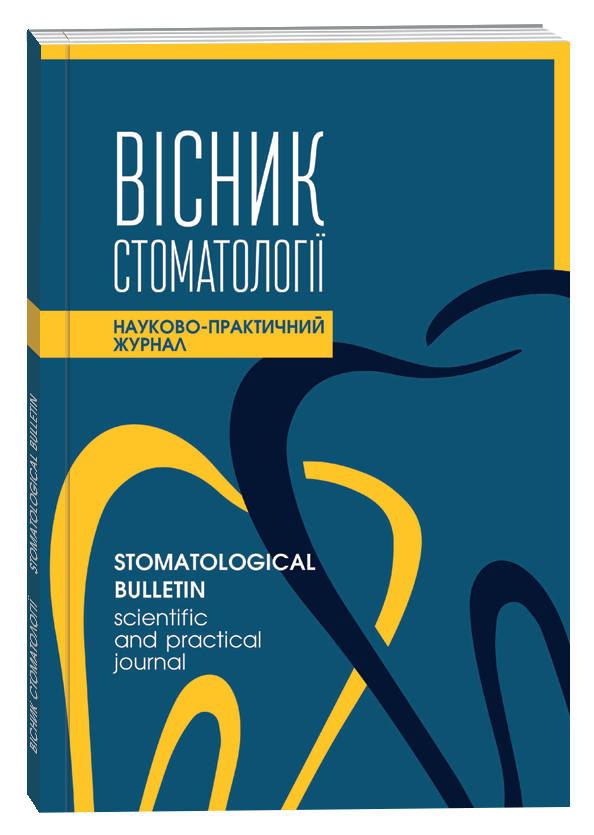STUDY OF THE PHYSICAL PROPERTIES OF SALIVER IN CHILDREN WITH ASTHMA
DOI:
https://doi.org/10.35220/2078-8916-2020-35-1-67-74Keywords:
children, asthma, saliva, buffer capacity, quntity of saliva, viscosity of saliva, pHAbstract
Actuality. It is known that saliver is an important biological environment, its chemical and physical properties affect the condition of the teeth and mucous membrane of the oral cavity. Among the caries risk factors, a significant place is due to changes in the composition and properties of the saliver.
Among the somatic pathology that significantly affects the caries development belongs to asthma. Asthma is accompanied by a change in a number of immunological and pathophysiological parameters of the body and is the most common allergic disease of childhood. Treatment of asthma involves the oral application of B2 –agonists of short and long action and inhaled glucocorticosteroid drugs, which affects the physical properties of the saliver, namely, the quantity of salivation, viscosity and pH of saliva, etc.
Thus, further research on the physical properties of saliva in children suffering from asthma is relevant.
Purpose of the study: of the study was to determine the concentration of hydrogen ions (pH), the buffer capacity, consistancy, quantity of the saliver in children suffering from asthma.
Materials and methods of research. It was examined 70 children aged 7, 12 and 15 years suffering on asthma. To study pH, buffer capacity, viscosity and quntity of salivation we performed saliver research on the basis of the sets of the test system Saliva Check Buffer (GC). It was examined 72 children of control the same age, to compare the results of saliver. The results were statistically processed using Fisher's criterion.
Results. It was found that the ph of the saliva in children with asthma was (6.49 ± 0.10) on average, which is low-er compared to children of control group (7.10 ± 0.10). The same tendency is observed concerning the buffer ca-pacity of the saliva, respectively: 5.89 ± 0.19 in children with asthma vs. 6.98 ± 0. 12 in almost healthy children. There was a decrease in quntity of salivation in children with asthma compared with children of the control group (5. 94 ± 0.25 ml vs. 9. 26 ± 0.38 ml, respectively, p <0.001). Relative to the viscosity of the saliva, opposite results were found, namely, an increase in the quntity of children with a higher level of viscosity in children with asthma compared with children of control group.
Conclusions. The obtained results of the study indicate a cariogenic situation in the oral cavity in children with asthma due to the decrease in pH, buffer capacity and quantity of saliva , as well as an increase in the viscosity of the saliva. This will enable us to take into concideration the adverse changes of the physical param-eters of saliva in the development of individual programs for the caries prevention in children with asthma.
References
Боровский Е. В. Биология полости рта / Боровский Е. В., Леонтьев В. К. ‒ М: Медицина, 2001. Боровский Е. В., Леонтьев В. К. 303с.
Кулигіна В. М. Динаміка змін показників біофізичного дослідження ротової рідини та рівня гігієни порожнини рота у підлітків з множинним карієсом зубів після лікування та проведення вторинної профілактики / В. М. Кулигіна, Л. Ф. Курдиш // Современная стоматология. – 2010. –№ 4. – С. 162-164.
Лосик И. М. Биофизические показатели ротовой жидкости у детей с детским церебральным параличом / И.
М. Лосик, Т. Н. Терехова // Современная стоматология. – 2009. − № 3-4. − С. 88-89.
Скрипкина Г. И. Взаимосвязь физико-химических параметров ротовой жидкости кариерезистентных детей / Г. И. Скрипкина // Стоматология детского возраста и профилактика. – 2011. – № 3. – С.22-25.
Вольхина В. Н. Клинико-лабораторная характеристика состояния полости рта и профилактика стоматологических заболеваний у детей с бронхиальной астмой: автореф. дисс. на соискание ученой степени канд. мед. наук: спец. 14.01.21. «Стоматология» / В.Н. Вольхина. – Екатеринбург, 2000. – 24 с.
Сучасна класифікація бронхіальної астми у дітей. / Ю.Г. Антипкін, В.Ф. Лапшин, Т.Р. Уманець [та ін.] // Перинатология и педиатрия. ‒ 2011. ‒ №1(45). ‒ С.8-10.
Балаболкин И. И. Современные проблемы терапии бронхиальной астмы у детей / И. И. Балаболкин // Педиатрия. ‒ 2009. Т.87. ‒ №2. ‒ С.6-11.
Видойник О. Я. Показники гомеостазу ротової порожнини у дітей зі стома тологічною захворюваність на фоні бронхіальної астми / О. Я. Видойник // Вісник проблем біології і медицини. – 2014. – Вип. 3, Т.1. ‒ С.47-49.
Забелина Н. А. Скорость слюноотделения и некоторые параметры ротовой жидкости у детей, больных аллергодерматозами / Н.А.Забелина // Современная стоматология. ‒ 2000. ‒ №1. ‒ С. 32-33.
Адмакин О. И. Стоматологический статус детей 12-летнего возраста, страдающих аллергической патологией / О.И. Адмакин // Стоматология. ‒ 2007. ‒ № 2. ‒ С. 80-85.
Алескерова С. М. Состояние твердих тканей зубов у больних бронхиальной астмой / С. М. Алескерова // Вісних проблем біології і медицини – 2011. ‒ Вип. 2, Т. 3. – С. 224 – 227.
Романенко И. Г. Состояние гигиены полости рта и тканей пародонта у детей с хроническим генерализован-ным катаральным гингивитом на фоне бронхиальной астмы. / И. Г. Романенко // Вiсник проблем бiології i медицини. ‒ 2014. – Том 2 (2). ‒ С. 121-123.









